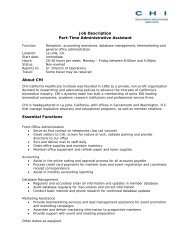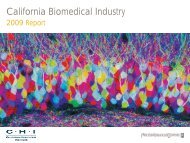California Biomedical Industry - California Healthcare Institute
California Biomedical Industry - California Healthcare Institute
California Biomedical Industry - California Healthcare Institute
Create successful ePaper yourself
Turn your PDF publications into a flip-book with our unique Google optimized e-Paper software.
Stem cell science: Putting the tools to excellent use“Problems in human medicine andhuman biology are just plain hard,” saidLawrence S.B. Goldstein, Ph.D., directorof the UC San Diego Stem Cell Programand a key leader in the San DiegoConsortium for Regenerative Medicine.“They take many years of effort to solve.They take many scientists and staffpeople working together to solve them.And they take money.”For all of those reasons, Goldsteinbelieves that <strong>California</strong> is the place to befor stem cell researchers today.Goldstein was co-chairman of thescientific advisory committee forthe campaign to pass <strong>California</strong>’sProposition 71, and he said that CIRMhas delivered on its potential. “For thefirst five years, CIRM was tool building,”he said. “The second five years — now —is tool utilization.”The institute has accelerated stem cellresearch — and cemented <strong>California</strong> asthe innovative leader in the emergingfield — in four key ways, Goldstein said.“First, CIRM is absolutely supportingscientific projects that would not haveotherwise been supported,” he said.“Stem cell research projects are soinnovative that they would not haveattracted federal funding.” For the NIHand other granting federal agencies,“Innovative equals controversial, andcontroversy splits votes on reviewpanels.” Given the intense competitionfor NIH grants, it is understandableand perhaps even appropriate forthe institutes of health to select moretraditional and incremental projects tosupport.Among the projects to receive CIRMgrants has been under John Zaia’sdirection at City of Hope. His teamplans to modify hematopoietic stemcells from HIV patients to make thecells more resistant to HIV. Whenre-infused, these altered cells mayreconstitute the patients’ immunesystems. A similar project throughMichele Calos’ lab at Stanford willattempt to add a missing gene to musclestem cells from boys with Duchenemuscular dystrophy (DMD). The goalis to create new, healthy muscle cellsin the bodies of DMD patients, whosedisease is invariably fatal. If successful,the technique could be applicable inthe treatment of other degenerativedisorders and, perhaps, in degenerativeconditions that occur in normalaging. Another CIRM-funded project,conducted by J. William Langston’slab at The Parkinson’s <strong>Institute</strong>, aimsto develop iPS cells from patientswith Parkinson’s disease and use theresulting cell lines for Parkinson’sresearch and drug discovery.These investigations, and many othersunderway, are expected to yield newscientific knowledge that could proveuseful to all stem cell researchers.More importantly, CIRM is drivingtranslational development projects tomake breakthrough new treatmentsavailable to patients as soon as is feasible.The second way CIRM has catapultedstem cell research forward has beenthrough a number of financing roundsdesigned to draw new researchers to thefield and to provide the training theyneed to not only get up to speed but tolead the science forward. In fact, theinstitute’s first round of funding was fortraining grants that enabled <strong>California</strong>public colleges and universities andnon-profit academic and researchinstitutions to provide stem cellresearch training to pre-doctoralstudents, post-doctoral students andclinical fellows. The programs were tobe available and applicable to studentsfrom scientifically and ethnically diversebackgrounds. Further, the programswere to offer one or more classes instem cell biology as well as a requiredcourse in the social, legal and ethicalimplications of stem cell research.Another round of training financingunderwrote stem cell techniquescourses. Two new faculty roundsfocused on bringing new instructorsinto stem cell programs. The firstfocused on funding young medicalstudents and doctoral scientists asindependent investigators and asfaculty members establishing their ownlabs. The second round paid particularattention to recruiting new physicianscientistsinto the field.Not only are these recruits inspiringundergraduate and graduate studentsto pursue stem cell research, Goldsteinsaid, “These are people who are going tostart and run companies.”Goldstein was instrumental in UC SanDiego being awarded a $1.2 millionCIRM grant to train the next generationof stem cell researchers. The programis providing interdisciplinary trainingin stem cell biology and medicine for16 scientists — six doctoral students,four postdoctoral fellows and six clinicalfellows — enrolled at the School ofMedicine, Division of Biological Sciences,Division of Physical Science, SkaggsSchool of Pharmaceutical Sciences,Jacob’s School of Engineering at UCSD,or at the Salk or Burnham <strong>Institute</strong>s.94 | <strong>California</strong> <strong>Biomedical</strong> <strong>Industry</strong> 2011 Report






